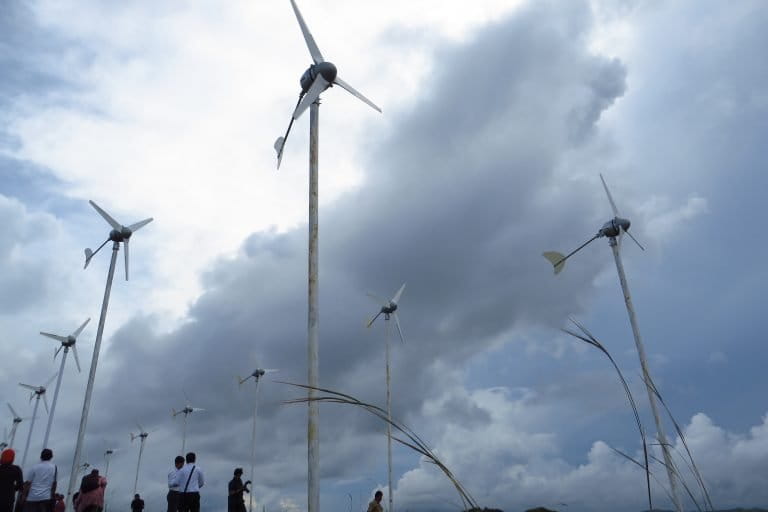- Indonesia will have to come up with its own funding schemes to have any chance of achieving its carbon emissions reduction target by 2030, a new study says.
- The government has calculated that it needs $323 billion in funding from the international community to slash emissions by 41%, but received just $6.4 million between 2007 and 2019, the study found.
- It found that Indonesia faced difficulties accessing international climate grants, with donors often prioritizing their own interests or preferring countries with lower incomes than Indonesia.
- A potential source of funding could be the sale of government debt that’s a combination of environmental (green) bonds and Islamic-compliant bonds, known as sukuk, the study says.
JAKARTA — Indonesia, a top greenhouse gas emitter, will need far more than the international funding it has already been promised if it’s to achieve its carbon reduction goals, a new study says.
Under its commitment to the Paris climate agreement, known as its nationally determined contribution (NDC), Indonesia plans to slash its emissions by 29% by 2030 against the business-as-usual projection. With international funding, or the “conditional” scenario, the target goes up to 41%. To achieve the latter, the Indonesian government has calculated that it will need $322.86 billion.
But between 2007 and 2019, it received just $6.4 million in international climate finance support, mostly in the form of loans, according to Ministry of Finance data. To plug that massive shortfall, Indonesia will need to develop innovative means of independent funding, according to the study by researchers from the Bandung Institute of Technology (ITB).
“The Indonesian government needs a tremendous amount of climate finance to meet these targets,” they write in their paper in the journal Environmental Science & Policy. “However, the [government] still faces obstacles closing the gap between climate finance availability and the required funds to achieve the [emissions reduction] target.”

To arrive at the numbers, the researchers analyzed data obtained through interviews and discussions with key officials from the Ministry of National Development Planning, the Ministry of Energy and Mineral Resources, and the Ministry of Foreign Affairs, the South Korea-based Global Green Growth Institute, and an unnamed multinational geothermal energy company between December 2020 and December 2021.
They found that the Indonesian government faced difficulties accessing international climate grants, as donors often prioritized their own interests. The authors also said that international grants were typically prioritized for countries with lower incomes than Indonesia, which is a member of the G20 group of the world’s biggest economies.
As such, grants made up just 4% of the $6.4 million in pledged financing from the international community. The rest was in the form of loans, which the researchers said the Indonesian government preferred because the social and economic benefits were greater than from grants. “However, this type of instrument causes challenges for developing countries because loans need to be repaid on a term and are added with interest,” they write.

In 2009, industrialized countries promised to provide $100 billion a year by 2020 for less-industrialized ones to reduce emissions, and for the most vulnerable countries to overcome the negative impacts of climate change. However, the most they could pony up was $78.9 billion in 2018. The failure to achieve the 2009 pledge was mainly attributed to the lack of a system to accurately track the financing instruments.
Given these limitations surrounding international climate financing, the study says, Indonesia cannot rely solely on support from this quarter, and must create new independent financing schemes to achieve its emissions reduction goals.
Bond sales could be key, the paper says, in particular the unique combination of environmental (green) and Islamic-compliant bonds (or sukuk). In 2018, the Indonesian government raised $1.25 billion from issuing such an instrument, hailed as the first sovereign green sukuk in the world. Funds raised from such an instrument go to finance government projects that are both environmentally friendly and compliant with Islamic laws on financing. But some observers have raised concerns over the convoluted system to identify eligible projects, and have also noted the challenge of putting green financing into action.
“[A] more innovative climate change financing strategy could include the following funding sources,” the new study says, “such as the non-public sector through banking, the capital market, and securities instruments to attract domestic and international funding.”
Citation:
Suroso, D. S. A., Setiawan, B., Pradono, P., Iskandar, Z. S., & Hastari, M. A. (2022). Revisiting the role of international climate finance (ICF) towards achieving the nationally determined contribution (NDC) target: A case study of the Indonesian energy sector. Environmental Science & Policy, 131, 188-195. doi:10.1016/j.envsci.2022.01.022
FEEDBACK: Use this form to send a message to the author of this post. If you want to post a public comment, you can do that at the bottom of the page.














